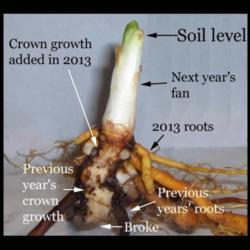Awesome article, Maurice, thank you! These are some generally savvy and hard working daylily roots, for sure, and it was fascinating to learn more about what we see as we observe their activity and root systems. The temperature side of the experiment seems to have been designed to test for root-contracting-work during large daily temperature fluctuation, so I can only wonder if there might be some different result when the temps are extreme hot or cold but fairly constant (less than 20 degrees between day/night). Indeed, the function of daylily roots to move the plant downward, store up nutrients, and spread daughter corms, might also include the benefit of increased depth to accommodate much larger leaf/plant size.
I'm inspired by OldGardener's idea that we extreme growers might try some informal ways to observe differences in our own pots and beds. I think I will take some fans of the same cultivar and try 1) very shallow, 2) 1-inch, and 3) 2-inch crown depths in each main planting area and then leave one set undisturbed in their natural movements, and one set lifted up each spring/fall. My take on the article was that beyond 50mm/2-inches crown depth there may definitely be a negative effect in the vigor of the plant, as leaves are pulled too far under the soil and away from light...?). So this totally matches Michele and Fred's observation that keeping or repositioning crowns at 1-inch or less may well result in better vigor and blooming.
I'm still very curious to see if there might result some difference in growth or health in the extreme-but-stable range of temperatures based on crown depth. I'll also try to be more aware of whether there are different soil areas that produce different crown depths based on soil's chemical composition, as I think the article implies may be possible. Micro-location is one factor I did not pay much attention to as I was pulling fans in random order from different bed and potting areas. Sometimes I get different planting medium into the pots or beds, if only by virtue of using soil material from different suppliers over time, though it may be that OldGardener has been more consistent with that.
Regarding winter heaving, Maurice, I recently read about "bricking" where daylilies planted in cold-extreme areas may avoid heaving if there are bricks placed on the ground to surround or ring each fan/clump. The idea conveyed was that the bricks can pick up warmth during the day and radiate it back during the night, avoiding the heave altogether, though I am not sure how that warm-up/radiation would work under snow cover, or to what temperature it was believed to be effective.
These dang daylilies are just a constant source of marvel, delight, and fascination ...


